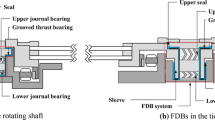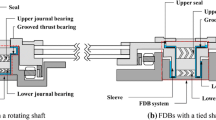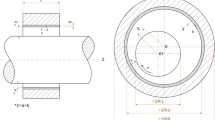Abstract
Tied-shaft type Fluid dynamic bearings (FDB) are widely used for small, high precision motor applications such as hard disk drives. This bearing contains two or more air-oil interfaces that cause the meniscus location to change as the bearing rotates from the stationary condition. To prevent oil shortage or leakage at the seal of the FDB, designing an internal geometry of the FDB that can maintain the airoil interface location at a suitable range is critical. This study proposes a system-level prediction model for the air-oil interface location in the taper seal element of the FDB in operating conditions. The FDB elements, grooves and a circulation hole are represented as pumps and flow resistance. With these representations, the FDB can be analyzed with a lumped parameter model. In addition, a hydrostatic equilibrium condition that incorporates capillary force at the meniscus in the taper seal element is used. The location of the meniscus is determined by the pressure difference between the upper and lower seal that is generated by the hydrodynamic effect inside the FDB in operating conditions. The characteristics of the FDB elements are obtained from CFD analysis and are used to solve five equations that predict the system-level performance characteristics: Upper/lower meniscus height, flow rate, pressure and flying height. With the proposed prediction model, the effects of the upper/lower chamfer location and the inclination angle of the circulation hole are investigated. These results confirm that an oil shortage occurs if the upper chamfer radius is below 1.5 mm, and the upper/lower chamfer radii have a bigger effect on the meniscus location than the inclination angle of the circulation hole.
Similar content being viewed by others
References
R. Ku, Dynamic Characteristics of hard disk drive spindle motors -Comparison between ball bearings and hydrodynamic bearings, Trans. ASME, J. of Tribology, 118 (2) (1996) 402–406.
K. Matsuoka, S. Obata, H. Kita and F. Toujou, Development of FDB spiral motors for HDD use, IEEE Trans. on Magnetics, 37 (2) (2001) 783–788.
S. Tohma, T. Isogai, T. Hirayama, T. Matsuoka, K. Yokozuka and S. Mori, Frequency analysis of hard disk drive spindle system supported by hydrodynamic bearings, J. of Advanced Mechanical Design System and Manufacturing, 1 (5) (2007) 717–725.
G. H. Jang, S. H. Lee and H. W. Kim, Finite element analysis on the coupled journal and thrust bearing in a computer hard disk drive, J. of Tribology, 128 (2) (2006) 335–340.
G. H. Jang and S. H. Lee, Determination of the dynamic coefficients of the coupled journal and thrust bearings by the perturbation method, Tribol. Lett, 22 (3) (2006) 239–246.
M. G. Kim, G. H. Jang and H. W. Kim, Stability analysis of a disk-spindle system supported by coupled journal and thrust bearings considering five degrees of freedom, Tribology International, 43 (8) (2010) 1479–1490.
T. Asada, Design of hydrodynamic bearing for mobile hard disk drives, IEEE Trans. Magn., 41 (2) (2005) 741–743.
T. Asada, H. Saitou and D. Itou, Design of hydrodynamic bearing for miniature hard disk drives, IEEE Trans. Magn., 43 (9) (2007) 3721–3726.
N. Hishida, M. Hashimoto, T. Hirayama, T. Matsuoka and H. Yabe, Fundamental study on oil leakage from tapered seal at the ends of fluid film bearing for precision equipments, The Japan Society of Mechanical Engineers, 75 (751) (2009) 727–734.
J. M. Saleh, Fluid flow handbook, McGraw-Hill, New York, USA (2002).
H. Ataei, Y. T. Beni and M. Shojaeian, The effect of small scale and intermolecular forces on the pull-in instability and free vibration of functionally graded nano-switches, J. of Mechanical Science and Technology, 30 (4) (2016) 1799–1816.
P. Gennes et al., Capillarity and Wetting Phenomena -Drops, Bubbles, Pearls, Waves, Springer, New York, USA (2004).
S. W. Kang and D. Banerjee, Modeling and simulation of capillary microfluidic networks based on electrical analogies, J. Fluids Eng., 133 (5) (2011) 054502.
M. Mainland and I. Green, Analysis and optimization of semicircular and straight lobe viscous pumps, ASME Trans. J. Tribol., 114 (1992) 515–523.
D. Blanchard and P. Ligrani, Comparisons of different viscous pumps based on physical flow behavior, Sensors and Actuators A, 126 (2006) 83–92.
B. J. Hamrock, R. S. Steven and B. O. Jacobson, Fundamentals of fluid film lubrication, CRC Press, New York, USA (2004).
Author information
Authors and Affiliations
Corresponding author
Additional information
Recommended by Associate Editor Sangyoup Lee
Chang-Hwan Park received his B.S. from the KAIST in 1995, his M.S. and Ph.D. in Aerospace engineering at the same university in 1997 and 2005, respectively. He is currently a principal engineer at Samsung Electro-Mechanics. His research interests are in turbulent flow, designs of turbomachinery and CFD.
Sangook Jun is a Senior Researcher at Korea Aerospace Research Institute. He obtained a Ph.D. at Seoul National University in 2010, and a B.S. degree at the same university in 2002. His research topics of interest include multidisciplinary design optimization of complex engineering system by using probabilistic and stochastic approaches, and reduced order model to improve computational efficiency of computational fluid dynamics.
Rights and permissions
About this article
Cite this article
Park, C., Lee, D., Jung, I. et al. Prediction of air-oil interface location in tied-shaft type fluid dynamic bearings. J Mech Sci Technol 30, 4247–4257 (2016). https://doi.org/10.1007/s12206-016-0837-7
Received:
Revised:
Accepted:
Published:
Issue Date:
DOI: https://doi.org/10.1007/s12206-016-0837-7




